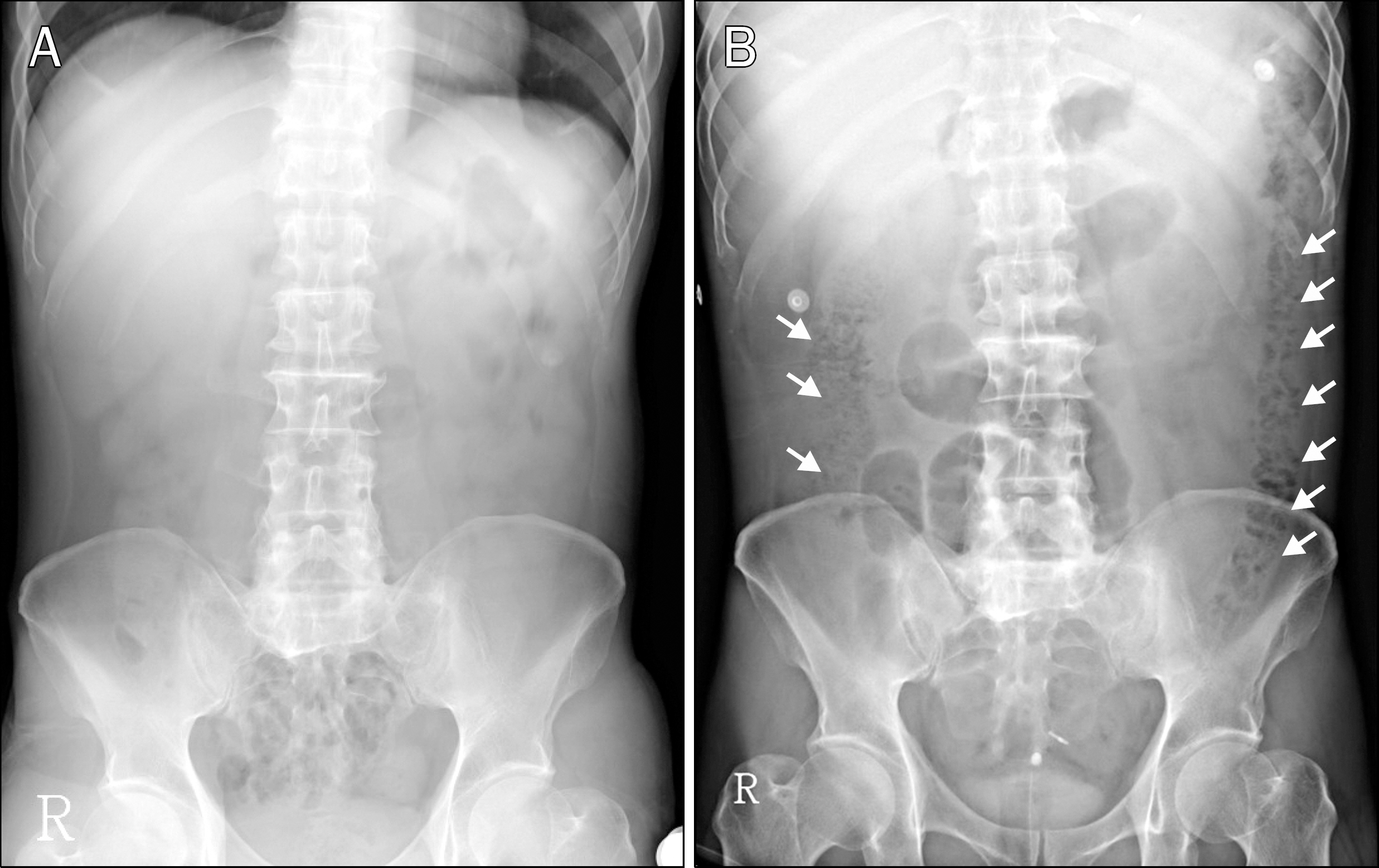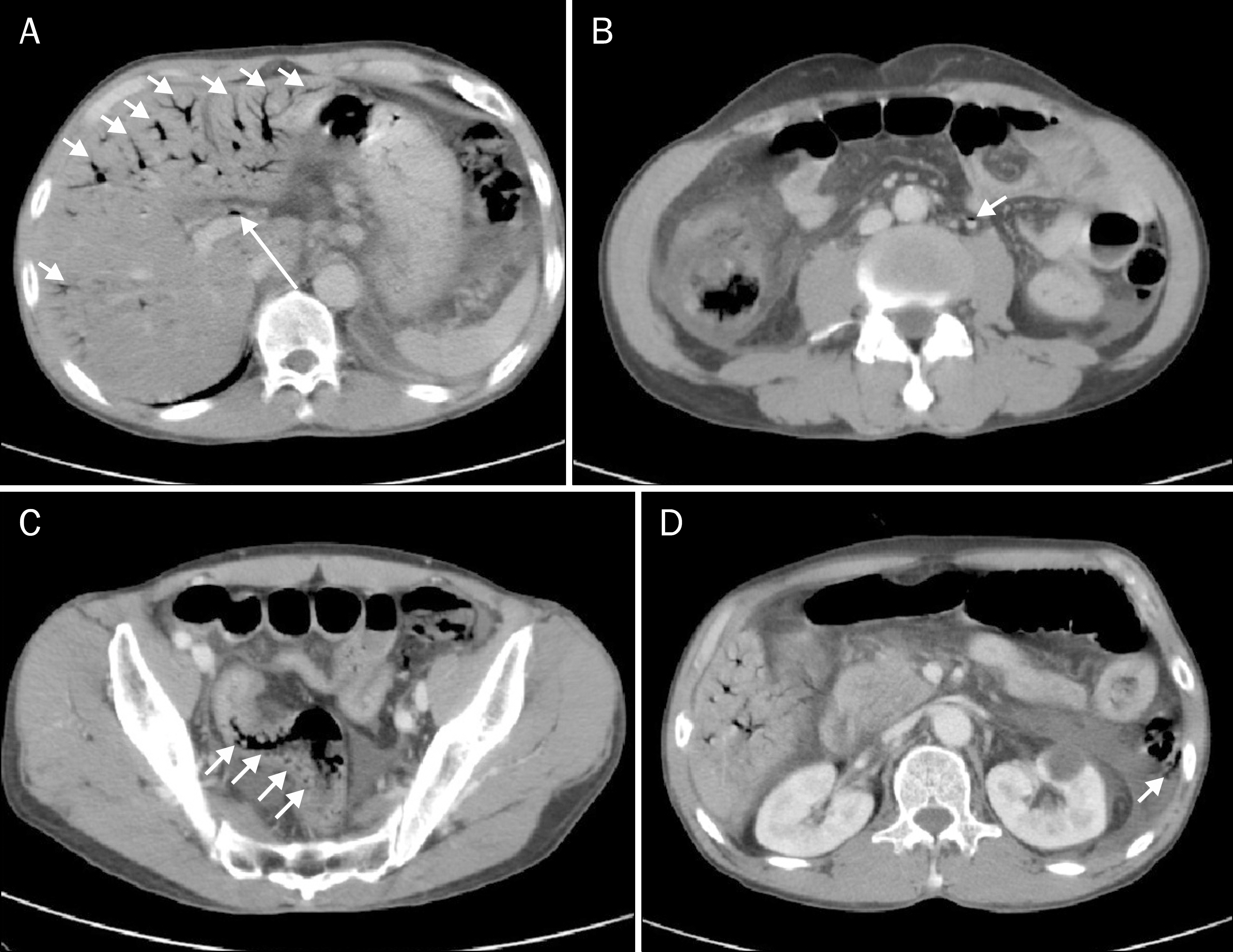Korean J Gastroenterol.
2015 Mar;65(3):177-181. 10.4166/kjg.2015.65.3.177.
A Case of Necrotizing Colitis Presenting with Hepatic Portal Venous Gas and Pneumatosis Intestinalis
- Affiliations
-
- 1Department of Internal Medicine, Korea University College of Medicine, Seoul, Korea. jskoo@korea.ac.kr
- KMID: 2373204
- DOI: http://doi.org/10.4166/kjg.2015.65.3.177
Abstract
- Hepatic portal venous gas is a very rare radiologic sign which is characterized by gas accumulation in the portal venous circulation. Pneumatosis intestinalis is also very rare and is characterized by multiple air cysts in the serosal or submucosal layers of the gastrointestinal tract walls. These two findings are caused by various pathological conditions and can develop individually or simultaneously. The latter is clinically more significant because it is frequently related to bowel ischemia or necrosis, and represents a poor prognosis. However, prognosis is more influenced by the severity of underlying disease rather than hepatic portal venous gas or pneumatosis intestinalis itself. If bowel ischemia or necrosis is the primary cause, emergency operation is very important to improve patient's prognosis. Herein, we report a case of necrotizing colitis presenting as hepatic portal venous gas and pneumatosis intestinalis which was successfully managed by early surgery.
MeSH Terms
Figure
Reference
-
References
1. Peloponissios N, Halkic N, Pugnale M, et al. Hepatic portal gas in adults: review of the literature and presentation of a consec-utive series of 11 cases. Arch Surg. 2003; 138:1367–1370.2. Ho LM, Paulson EK, Thompson WM. Pneumatosis intestinalis in the adult: benign to life-threatening causes. Am J Roentgenol. 2007; 188:1604–1613.
Article3. Ito M, Horiguchi A, Miyakawa S. Pneumatosis intestinalis and hepatic portal venous gas. J Hepatobiliary Pancreat Surg. 2008; 15:334–337.
Article4. Babaei M, Malek F, Mousavi S, Malek M. Pneumatosis cystoides intestinalis with hepatic portal venous gas: a rare finding with good outcome. Case Rep Clin Pract Rev. 2004; 5:369–372.5. Wiesner W, Mortelé KJ, Glickman JN, Ji H, Ros PR. Pneumatosis intestinalis and portomesenteric venous gas in intestinal ischemia: correlation of CT findings with severity of ischemia and clinical outcome. Am J Roentgenol. 2001; 177:1319–1323.6. Koami H, Isa T, Ishimine T, et al. Risk factors for bowel necrosis in patients with hepatic portal venous gas. Surg Today. 2015; 45:156–161.
Article7. Wolfe JN, Evans WA. Gas in the portal veins of the liver in infants; a roentgenographic demonstration with postmortem anatomi-cal correlation. Am J Roentgenol Radium Ther Nucl Med. 1955; 74:486–488.8. Gan HN, Tan KY, Chong CK, Tay KH. Finding hepatic portal venous gas in an adult patient: its significance. Singapore Med J. 2006; 47:814–816.9. McElvanna K, Campbell A, Diamond T. Hepatic portal venous gas–three non-fatal cases and review of the literature. Ulster Med J. 2012; 81:74–78.10. Wu LL, Yang YS, Dou Y, Liu QS. A systematic analysis of pneumatosis cystoids intestinalis. World J Gastroenterol. 2013; 19:4973–4978.
Article11. Azzaroli F, Turco L, Ceroni L, et al. Pneumatosis cystoides intestinalis. World J Gastroenterol. 2011; 17:4932–4936.
Article12. Abboud B, El Hachem J, Yazbeck T, Doumit C. Hepatic portal venous gas: physiopathology, etiology, prognosis and treatment. World J Gastroenterol. 2009; 15:3585–3590.
Article13. Adar T, Paz K. Images in clinical medicine. Pneumatosis intestinalis. N Engl J Med. 2013; 368:e19.14. Kim JO, Kim KH, Sohn DK, Kim AJ, Kim TK. Pneumatosis cystoides intestinalis with portal venous gas: two case reports. J Korean Soc Emerg Med. 2004; 15:47–50.15. Jang HJ, Lee J. Pneumatosis intestinalis and hepatic portal venous gas caused by necrotizing colitis. Korean J Gastroenterol. 2006; 47:407–408.16. Park HC, Lee WS, Joo SY, et al. Hepatic portal venous gas associated with acute pancreatitis: reports of two cases and review of literature. Korean J Gastroenterol. 2007; 50:131–135.17. Yang SY, Lee YJ, Park SY, et al. Hepatic portal venous gas. J Korean Geriatr Soc. 2010; 14:48–52.
Article18. Lee HM, Cho SY, Lim YS, Kim YK, Song HC, Choi EJ. Pneumatosis intestinalis with hepatic portal venous gas in a hemodialysis patient. Korean J Nephrol. 2011; 30:546–550.19. Yu SH, Eom YS, Lee DM, et al. A case of pneumatosis cystoides intestinalis and portal venous gas accompanied by emphysematous pyelonephritis in type 2 diabetes mellitus. J Korean Diabetes. 2014; 15:45–50.
Article
- Full Text Links
- Actions
-
Cited
- CITED
-
- Close
- Share
- Similar articles
-
- Pneumatosis Intestinalis and Hepatic Portal Venous Gas Caused by Necrotizing Colitis
- Necrotizing enteritis with portal vein gas and pneumatosis cystoides intestinalis treated with delayed operation
- Hepatic Portal Venous Gas
- Pneumatosis Intestinalis with Hepatic Portal Venous Gas in a Hemodialysis Patient
- Pneumatosis Cystoides Intestinalis With Portal Venous Gas: Two Case Reports




